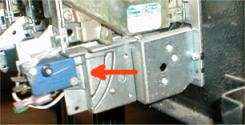Coin validators in pinball machines
Pinball games are commercial machines: they’re designed to earn money, which is why they include coin mechanisms. On all pinball machines, these are located inside the coin door. When you drop a coin into the slot, it passes through the coin mech and is checked. If it’s a valid coin that the machine accepts, it falls into the cash box and credits are added. If not, your coin is returned to the slot at the front of the door.
There are basically two types of coin mechs: mechanical and electronic.
Mechanical coin validator
As the name suggests, these are purely mechanical devices. Coins fall through the mechanism, which evaluates their weight, size, and magnetic properties. If the coin passes these tests, it triggers a microswitch as it drops into the cash box, and a credit is added. If it fails, the coin is diverted and returned to the player.
The switch that activates when a valid coin is inserted isn’t part of the coin validator itself, it’s mounted on the door frame. So even if the coin mech is removed, it’s still possible to add credits manually by triggering the switch (see red arrow in the picture).


These mechs are still popular in the USA, as most games accept quarters. They’re inexpensive, and most machines have two or three installed. If one jams or fails, another is still available. However, they can only accept one type of coin and can’t be easily changed to a different size (unless you modify them, on some you can bend some pins so they accept another size, you can remove the magnet,..). Another drawback is that they can jam.
Electronic coin mechs
Electronic coin validators can be programmed to recognize multiple coin types, usually up to ten. Most pinball machines in Europe use these. In the past, many countries had several coins in circulation that could be used to pay for a game. With the introduction of the euro, this remains true: most machines now accept 50 cent, 1 euro, and 2 euro coins.
In Europe, games typically have one coin slot with an electronic validator. These mechs offer several advantages: they accept multiple coin types, jam less frequently, and can be reprogrammed for different currencies. However, they’re more expensive, which is why many operators remove them when selling a machine.
Important: Never disconnect an electronic coin mech while the game is powered on!
The most types of coin validators user in Bally/Williams pinball machines are NRI and Coin Controls models C120 and C220.


There are two physical types: short and high. Mechanical coin mechs in pinball machines are always the short type. High types are mostly found in jukeboxes.
I’ve noticed that Bally/Williams games usually use high-type electronic coin mechs, while Data East games tend to use the short type. Some 1990s Bally/Williams machines even have both types installed: a few small mechanical mechs and one electronic validator. These configurations often depend on the country the game was produced for.
I don’t have exact measurements, but as seen in the pictures, the short model is nearly square and about half the height of a coin door, while the high model spans almost the full height of the door.
Electronic coin mechs connect via a dedicated connector to the pinball machine. Unlike mechanical mechs, there’s no separate switch triggered by the coin. So if your game uses an electronic validator, you can’t simply swap in a mechanical one. And if the electronic mech is missing, it’s impossible to simulate a coin insert by manually triggering a switch. The only way to play is by adding service credits (check your game manual) or setting the machine to free play.
Bill validators
Some machines also have bill validators installed. These operate similarly to electronic coin mechs. Recent Bally/Williams games (from around 1996–97) have coin doors that support bill validator installation. These were never factory-installed by default and, as far as I know, are mainly used in the USA.
Setting a Pinball Machine to Free Play
Setting a game to free play means you don’t need to insert coins to start a game: you can play as much as you want, for free. Just press the start button to start a new game.
On modern solid-state games, this is done via a software adjustment. Older solid-state games don’t have this option. You’ll need to cheat by adding a switch that tricks the game into thinking a coin was inserted, or set the replay value very low so every game earns you a free credit.
Electromechanical pinball machines have a credit wheel behind the backglass. There are several ways to modify these for free play: you can add a switch to simulate a coin insert, or disconnect the coil on the credit wheel so credits aren’t deducted.
Most games play a distinctive sound when a coin is inserted. That’s why many people prefer to keep their home machines on pay-for-play. Playing for money adds motivation and makes earning a free game more meaningful. The money collected can be used for parts or saved toward a new machine.
On WPC games, you can set free play in adjustment A.3-17: A. Adjustments > 3. Pricing Adjustments > 17. Free Play. Use the enter button to switch between Yes and No.
On Data East games, first select 'Expand Adjustments' (set to YES by pressing the start button when prompted), then continue until you reach 'Free Play'.
If you're looking for pinball parts, then check out Pinballshop.nl (affiliate link).
